3-way loudspeaker with an Audio Technology 12” woofer, the Bliesma 3” beryllium dome midrange and the Bliesma 1″ beryllium dome tweeter – passive crossover filter

- The transducers are the 12 inch Audio Technology 12B77 2510 as woofer, the 3 inch dome Bliesma M74B-6 as midrange and the Bliesma T25B-6 1 inch dome tweeter.
- The speaker cabinet is 110 cm high (incl. foot), 45 cm wide and 35 cm deep. The netto internal volume is 78 L, the woofer speaker system is closed box.
- The midranges and the tweeter are placed horizontal asymmetric on the front baffle to improve the SPL on axis and the DI index responses of the transducers mounted in the cabinet.
- The speaker sensitivity is 88 dB at 1m, 2.83 Vrms, full space.
The low frequency response F3 = 50 Hz, F6 = 41 Hz and F12 = 26 Hz.
For a woofer maximum excursion condition at 50 Hz the speaker maximum SPL is 108 dB @ 50 – 20000 kHz at 1m, free space. - An analog passive crossover filter is designed.
Using the voltage transfers of the final filter a 3-way analog active filter with opamps or tubes can be designed also.
A digital filter version is an option too. - This loudspeaker is very suitable to be used as a studio monitor. Replacing the tweeter transducer next to the midrange transducer, the loudspeaker can be used also on its side in a horizontal position.
Contents
- Specification Headlines
- Estimation Bill Of Material
- Speaker System
- Cabinet
- SPL and impedance curves of the transducers in the cabinet
- Polar diagrams of the transducers in the cabinet
- Off axis response, power and Directivity Index of the transducers in the cabinet
- Analog passive crossover filter
- Maximum excursion and maximum SPL with crossover filter
Specificaton Headlines
- System: 3-way, woofer closed box system, analog passive X-over
- Woofer: Audio Technology 12B77 2510
- Midrange: Bliesma M74B-6
- Tweeter: Bliesma T25B-6
- Low frequency response: F3 = 50 Hz, F6 = 41 Hz and F12 = 26 Hz
- Sensitivity: 88 dB at 1m, 2.83 Vrms, full space
- SPL at maximum excursion, 50 – 20000 Hz: 108 dB, 1m, full space
- Crossover: LR4 600 and 3200 Hz
- Cabinet dimensions incl. foot: width x heigth x depth = 45 cm x 110 cm x 35 cm
Estimation Bill Of Material
- 2 x Woofer : Audio Technology 12B77 2510: 1248 euro
- 2 x Midrange : Bliesma M74B-6: 1300 euro
- 2 x Tweeter: Bliesma T25B-6: 574 euro
- Components high quality crossover: 1000 euro
- Components medium quality crossover: 500 euro
- Cabinet material: 200 euro
- Cabinet Accessoires: 100 euro
- Total with high quality passive crossover 4122 euro
- Total with medium quality passive crossover 3622 euro
System
Transducers
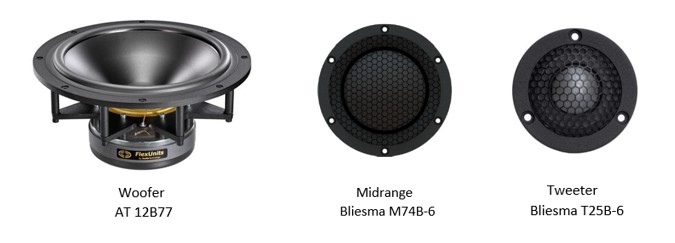
Audio Technology 12B77 2510, Bliesma M74B-6, Bliesma T25B-6
For the woofer we have chosen for a 12 inch transducer, the Audio technology 12B77 2510. With its high sensitivity of 94.0 dB @ 2.83 Vrms, 1m and its high maximal lineair excursion of 8.2 mm peak, it is very suitable to realize an overall sensitivity around 88 dB for this 3 way loudspeaker.
As midrange the new Bliesma 3 inch dome M74B-6 will be used. The sensitivity is 97 dB at 2.83 Vrms, 1m. The harmonic distortion of this transducer is very low, better than -60 dB between 900 and 3000 Hz at 2.83 Vrms. With a resonance frequency of 440 Hz and with its high sensitivity, this driver is capable to take over at 600 Hz, within its maximum lineair excursion of 1.2 mm peak.
The Bliesma T25B-6 is a 1 inch beryllium dome tweeter. The harmonic distortion of this transducer is low, better than -55 dB between 2200 and 8000 Hz at 2.83 Vrms.
Woofer – Small Signal Analysis
The 12 inch Audio Technology woofer is placed in a closed box of 78 L filled with sheep wool.
For this woofer: fs = 25 Hz; Vas = 250 L; Qts = 0.30 on infinite baffle (datasheet values).
Placed in the 78 L cabinet filled with wool: fc = 45 Hz and Qtc = 0.61.
The amount of filling can be determined by measuring the maximum impedance of the transducer at the frequency fc. It has to be about 34 Ohm for Qtc to be 0.61.
Cabinet
Cabinet dimensions
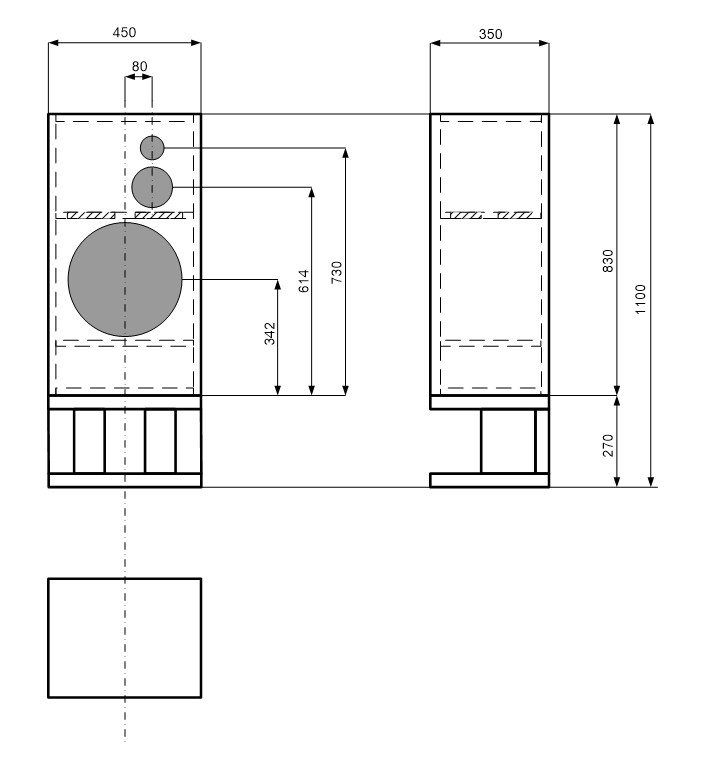
An optional position for the tweeter transducer is drawn in dotted line, to use the loudspeaker in a horizontal position for a studio application for example.
SPL and impedance curves of the transducers in the cabinet
These are the SPL and impedance curves of the transducers placed in the cabinet in free space at 3 meter, 2.83 Vrms . Also the SPL responses on infinite baffle are shown to see the impact of the cabinet shape on the response.
These simulated curves are used for a first crossover filter design.
SPL woofer in the cabinet on-axis in free space (blue curve) and on infinite baffle (pink curve)

Impedance woofer in the cabinet
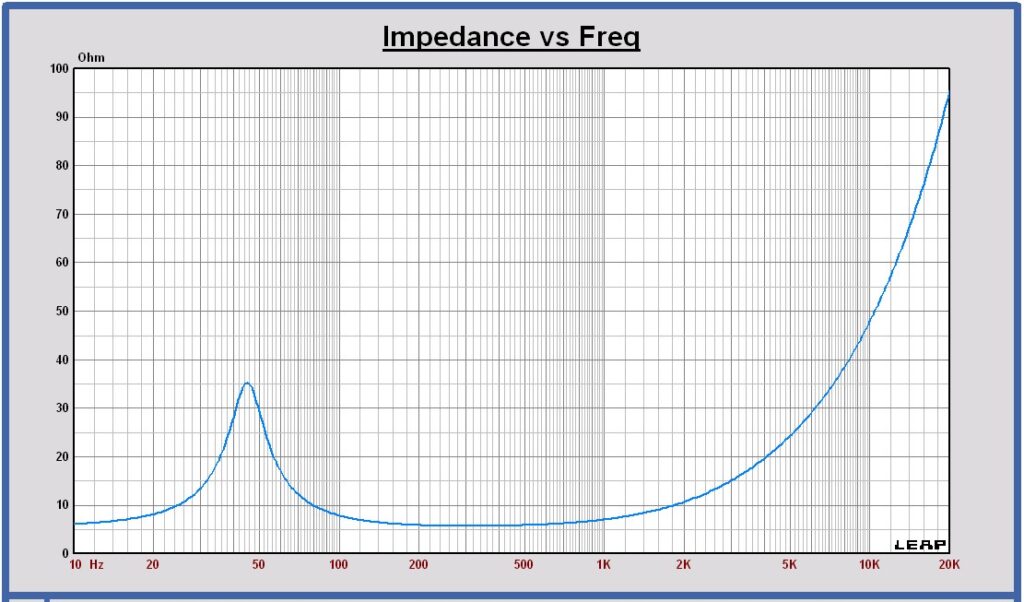
SPL midrange in the cabinet on-axis in free space (green curve) and on infinite baffle (pink curve)

Impedance midrange in the cabinet
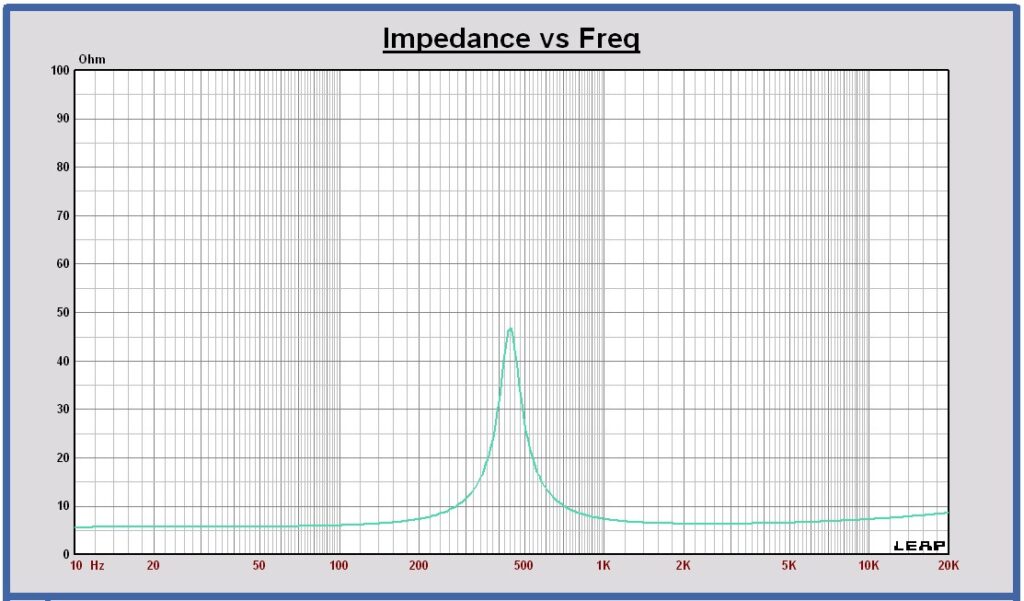
SPL tweeter in the cabinet on-axis in free space (red curve) and on infinite baffle (pink curve)

Impedance tweeter in the cabinet
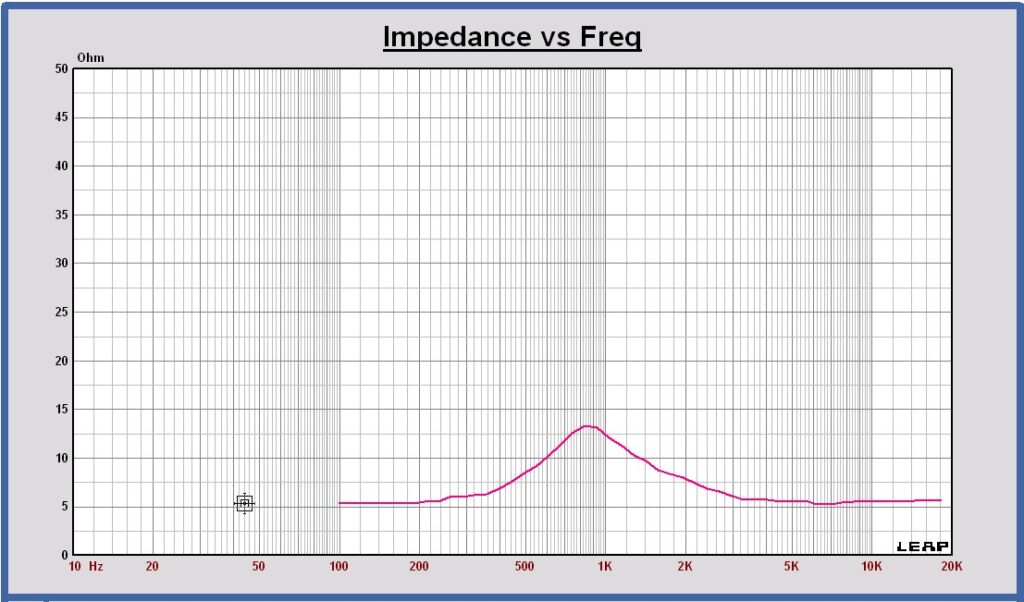
Polar diagrams
Horizontal polar diagram woofer in cabinet free space at 80 – 160 – 320 – 640 – 1280 Hz
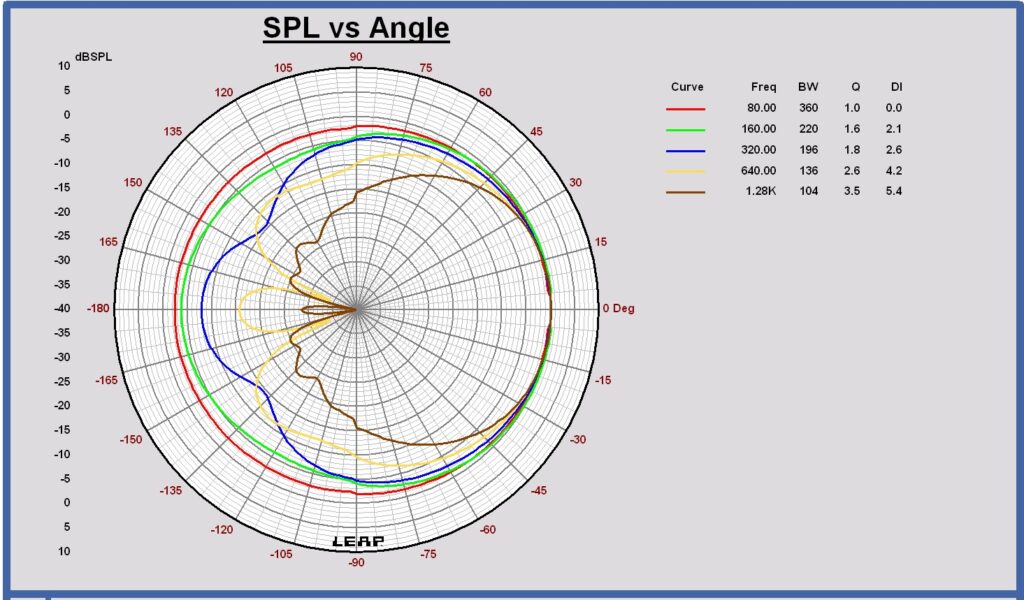
Vertical polar diagram woofer in cabinet free space at 80 – 160 – 320 – 640 – 1280 Hz
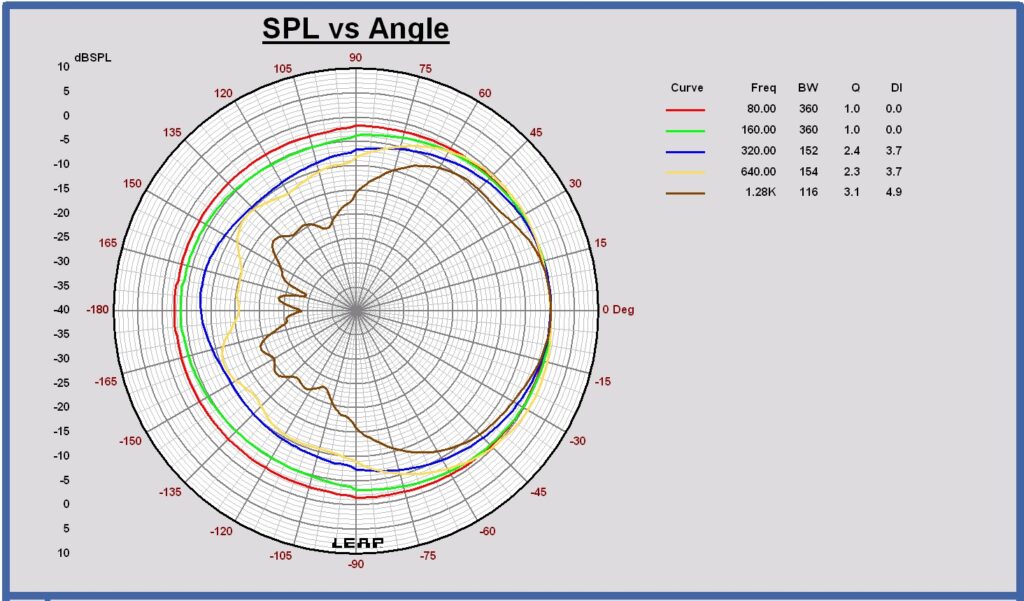
Horizontal polar diagram midrange in cabinet free space at 0.64 – 1.2 – 2.5 – 3.8 – 5.1 kHz
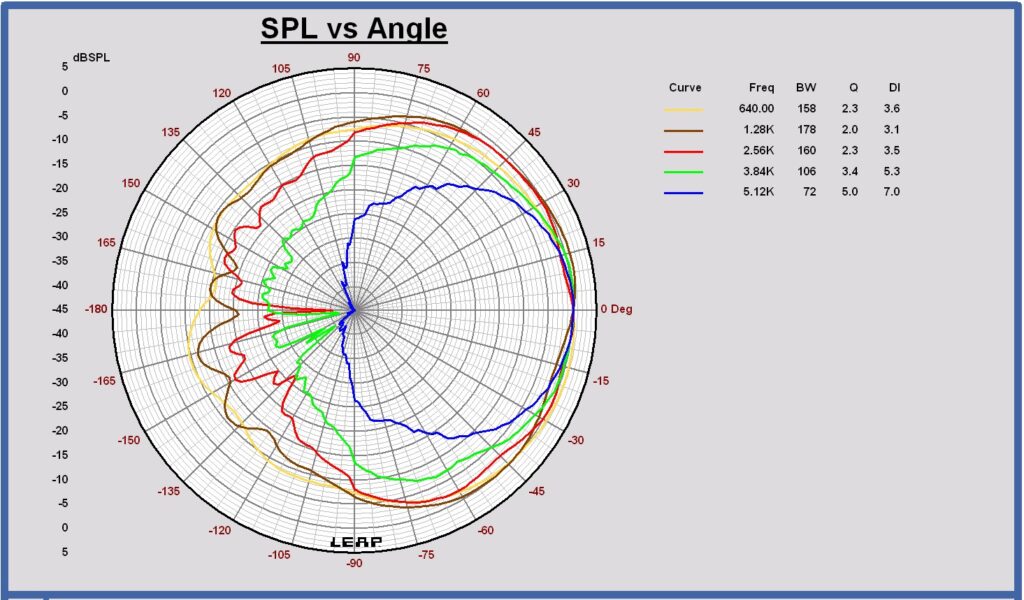
Vertical polar diagram midrange in cabinet free space at 0.64 – 1.2 – 2.5 – 3.8 – 5.1 kHz
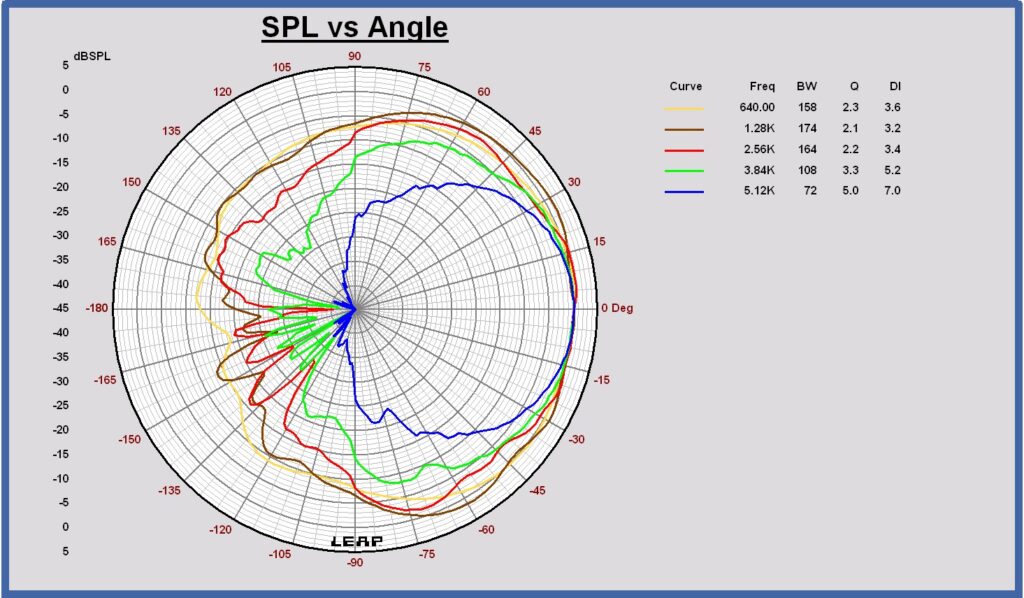
Horizontal polar diagram tweeter in cabinet free space at 2.5 – 3.8 – 5.1 – 6.4 – 12 kHz
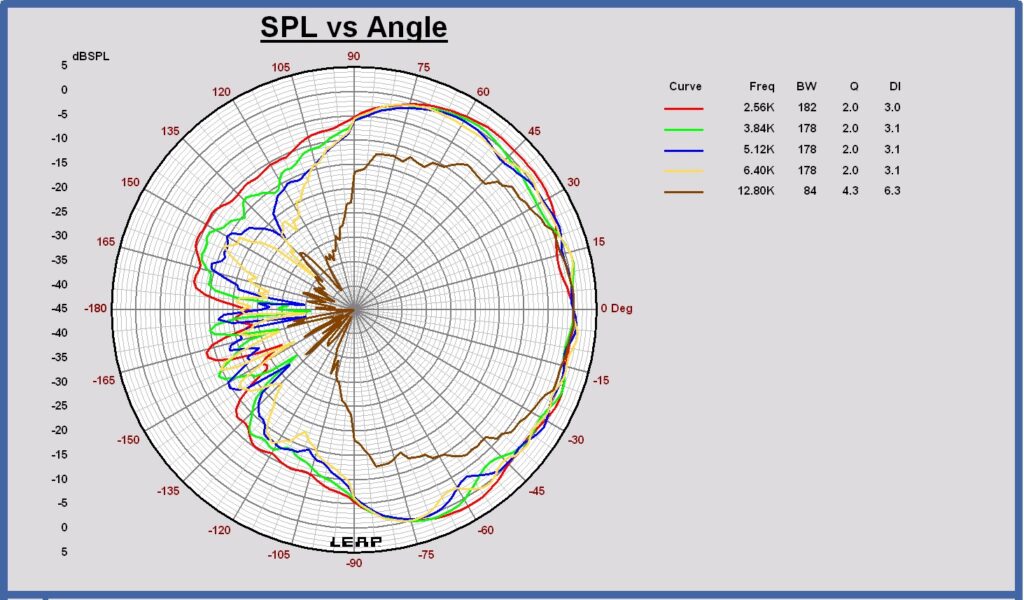
Vertical polar diagram tweeter in cabinet free space at 2.5 – 3.8 – 5.1 – 6.4 – 12 kHz
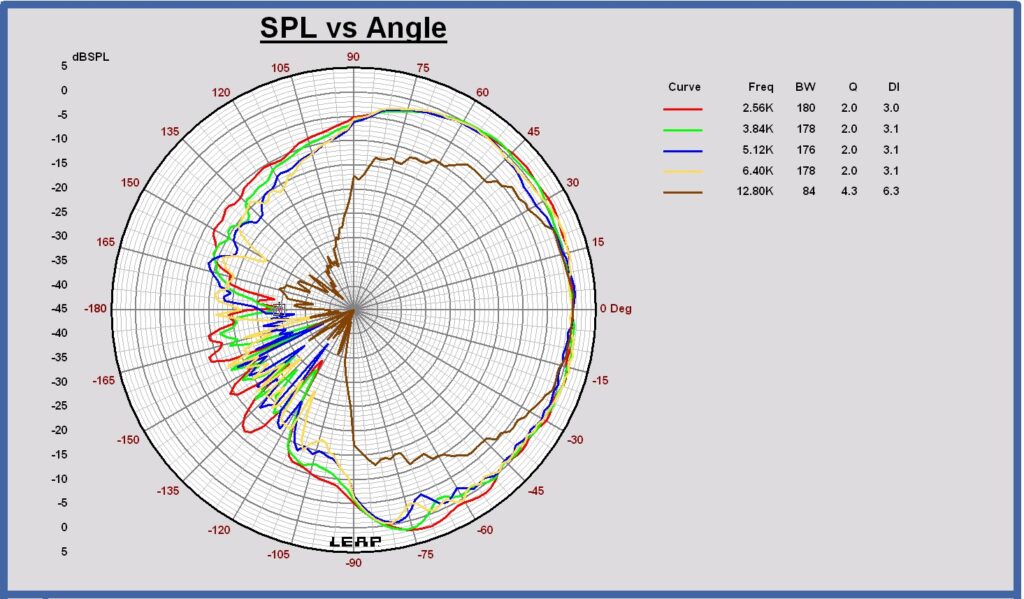
Off axis response, Power and Directivity Index of the transducers in the cabinet
To calculate the power response and directivity index, the horizontal and vertical SPL off axis responses of the woofer, the midrange and the tweeter are simulated in steps of 15 degrees, the speaker placed in a full sphere at 3m distance. The power is calculated out of the mean value of these curves. The power is represented as the SPL of an omnidirectional source at 3m distance in a full sphere with a SPL value equal to the power.
Woofer
Horizontal SPL on and off axis of the woofer in the cabinet at 0, 15, 30, 45, 60, 75 and 90 degrees
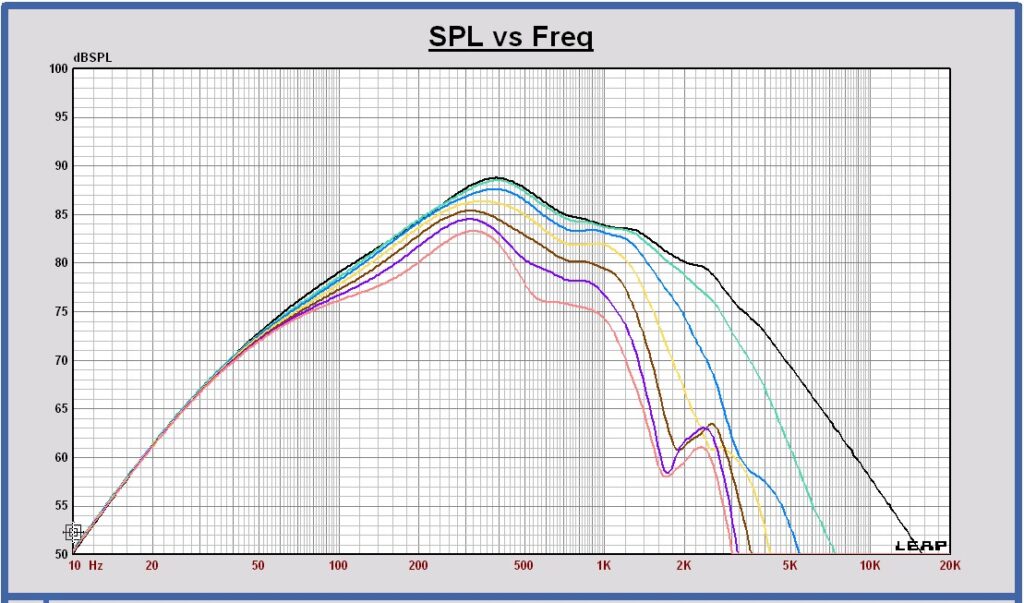
Vertical SPL on and off axis of the woofer in the cabinet at 0, 15, 30, 45, 60, 75 and 90 degrees
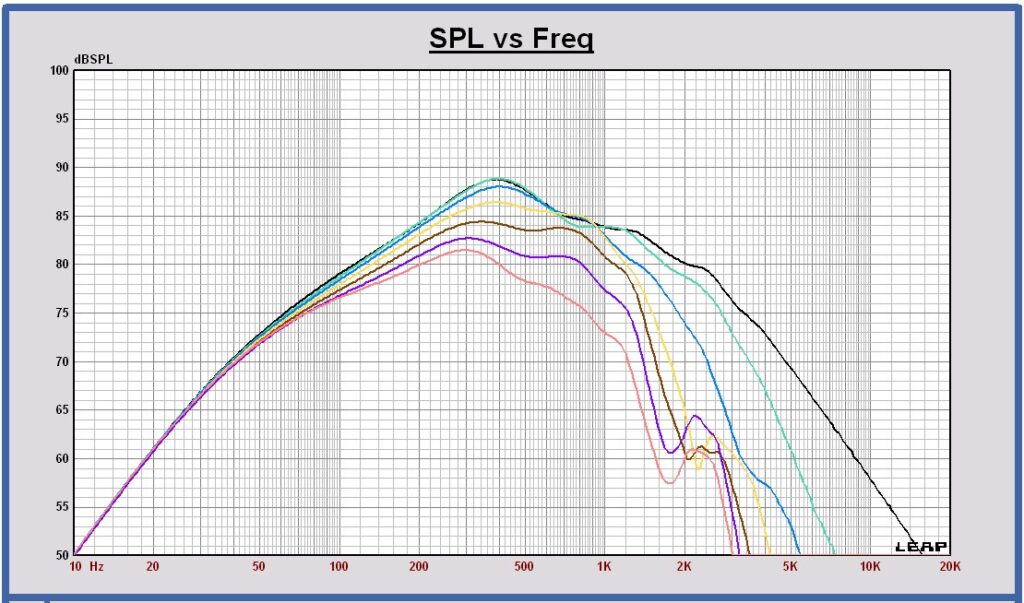
SPL on axis and Power of the woofer in the cabinet in a full sphere
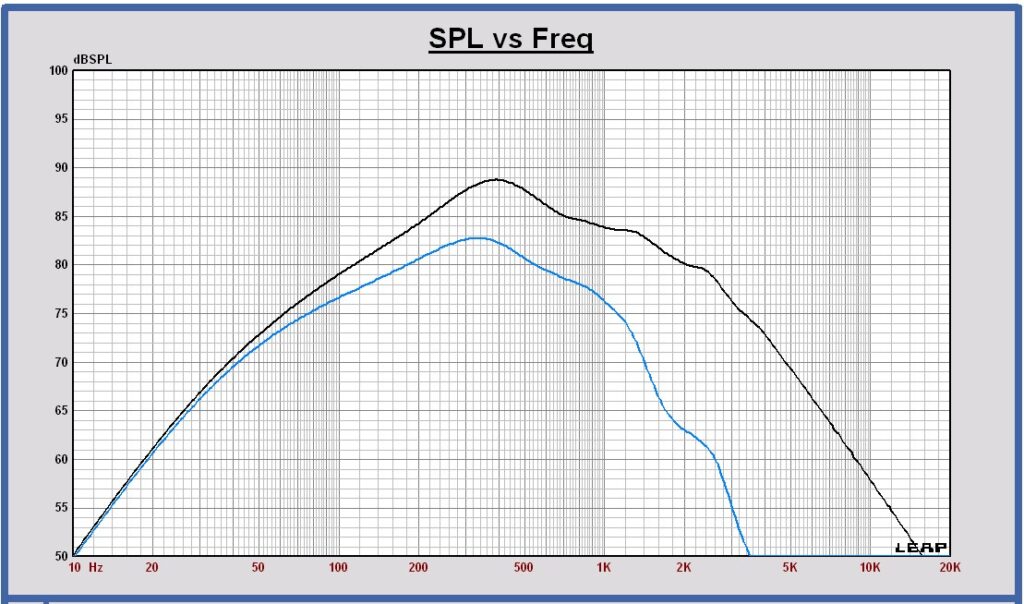
Directivity Index DI in a full sphere of the woofer in the cabinet
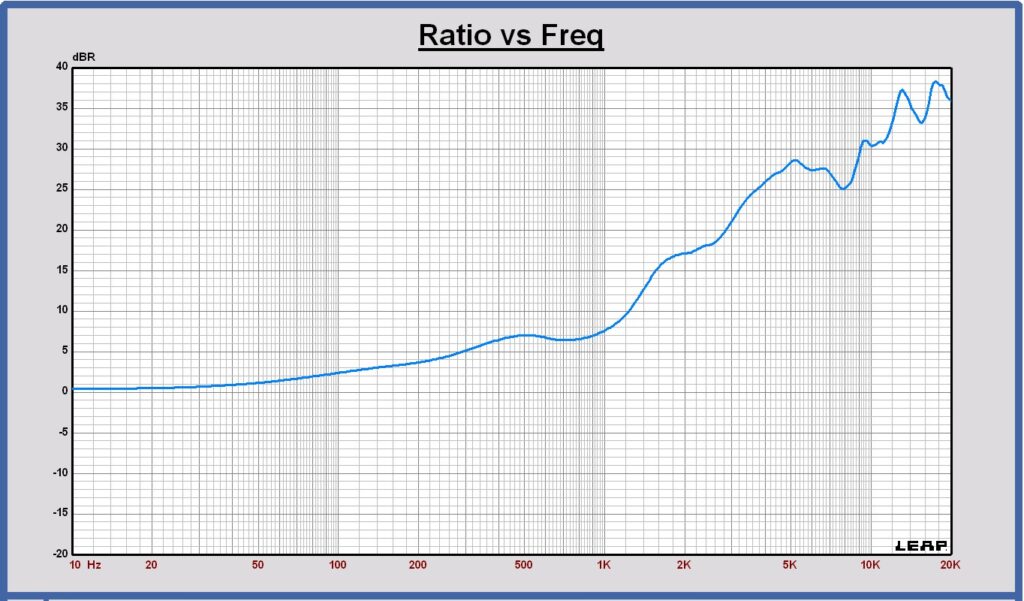
Midrange
Horizontal SPL on and off axis of the midrange in the cabinet at 0, 15, 30, 45, 60, 75 and 90 degrees
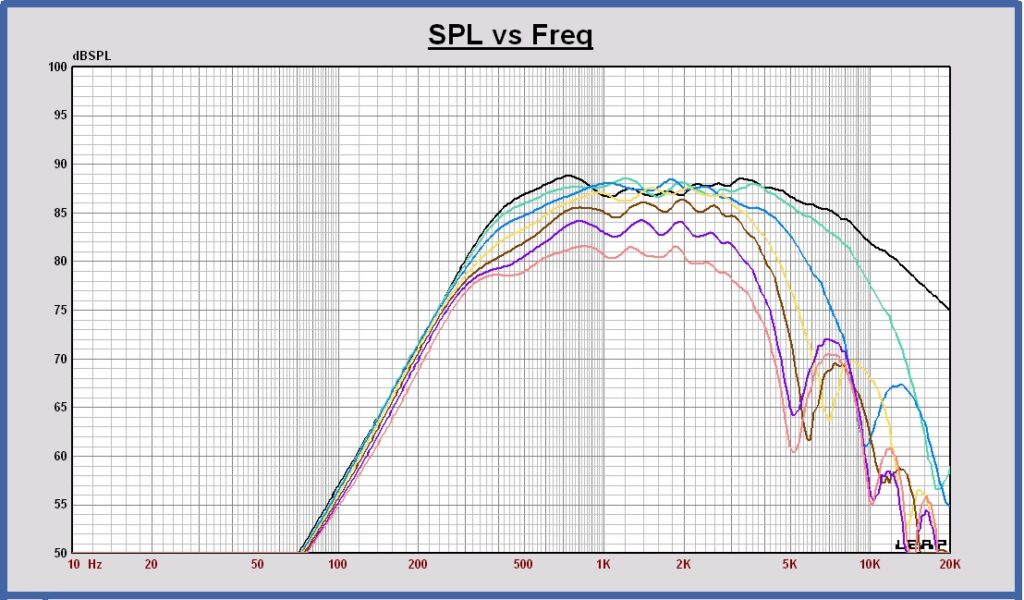
Vertical SPL on and off axis of the midrange in the cabinet at 0, 15, 30, 45, 60, 75 and 90 degrees
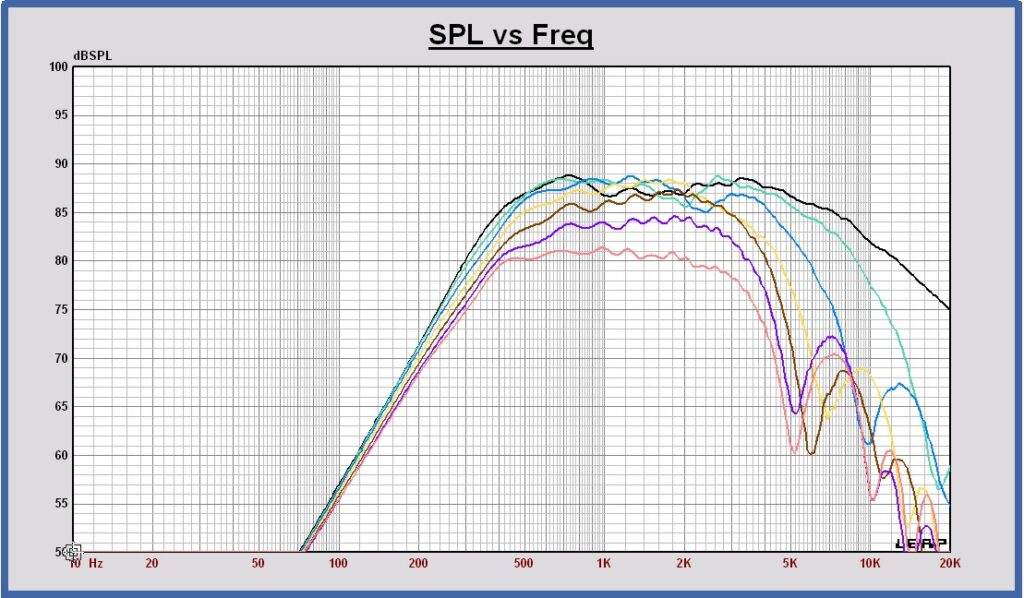
SPL on axis and Power of the midrange in the cabinet in a full sphere

Directivity Index DI in a full sphere of the midrange in the cabinet
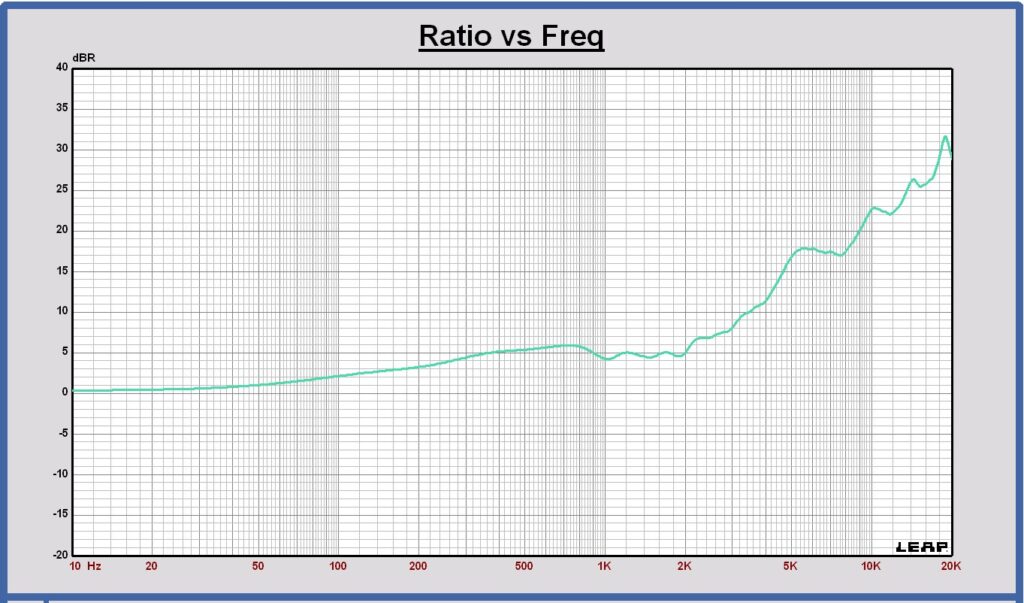
Tweeter
Horizontal SPL on and off axis of the tweeter in the cabinet at 0, 15, 30, 45, 60, 75 and 90 degrees
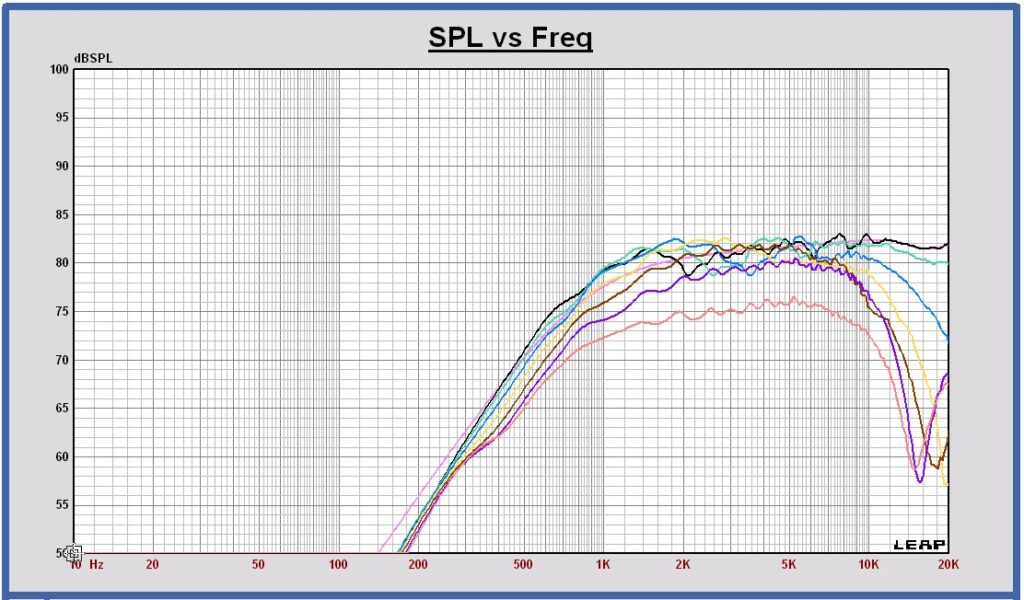
Vertical SPL on and off axis of the tweeter in the cabinet at 0, 15, 30, 45, 60, 75 and 90 degrees
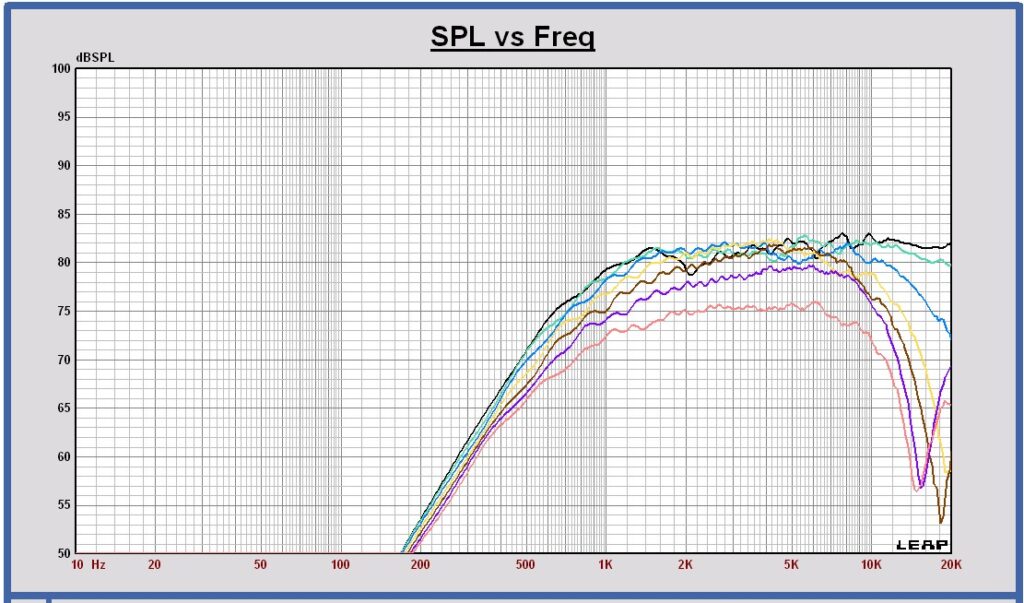
SPL on axis and Power of the tweeter in the cabinet in a full sphere
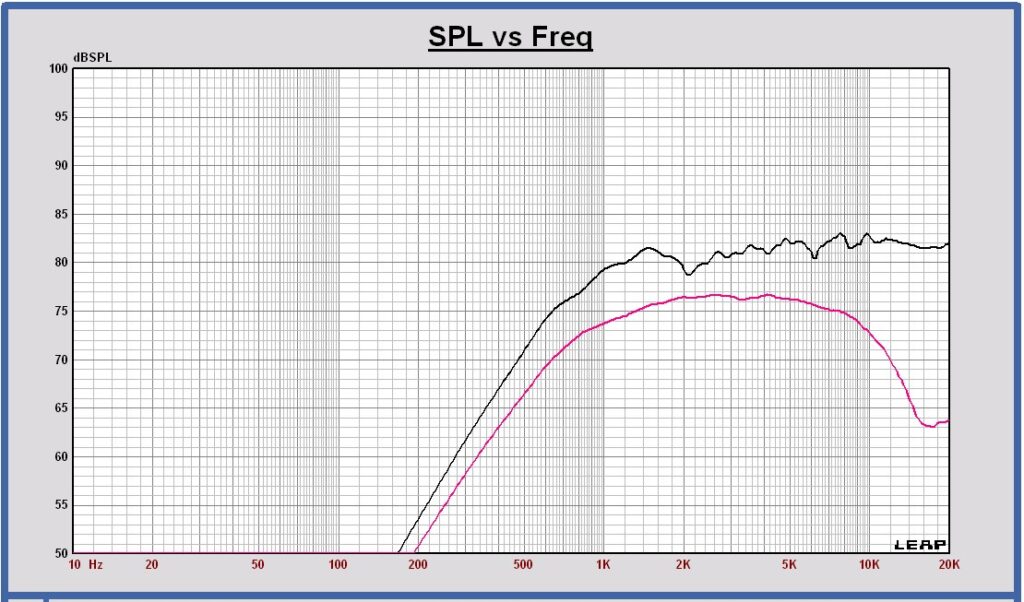
Directivity Index DI in a full sphere of the tweeter in the cabinet
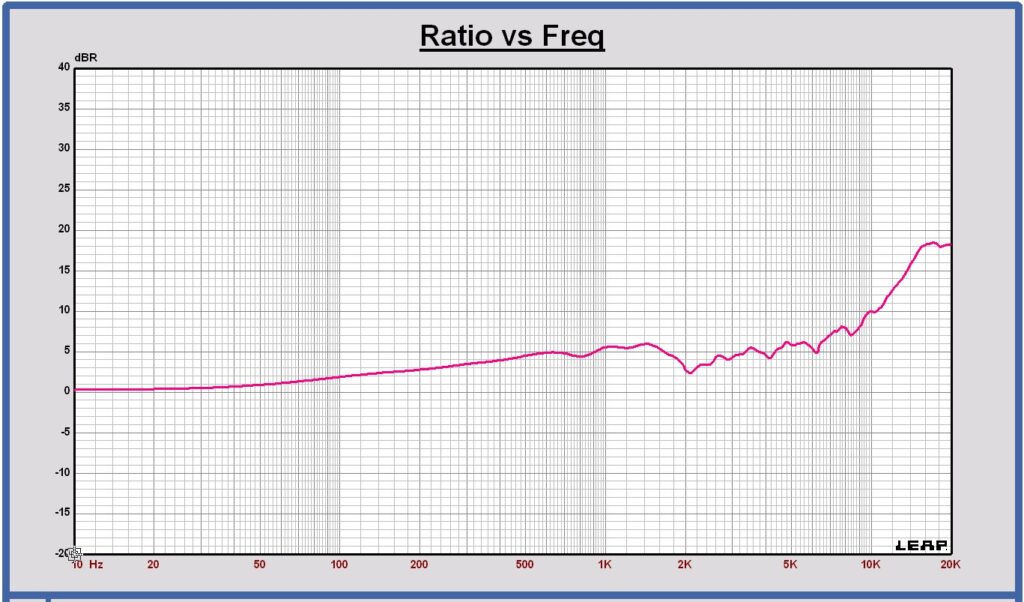
All transducers
Directivity Index DI in a full sphere of the woofer, midrange and tweeter in the cabinet
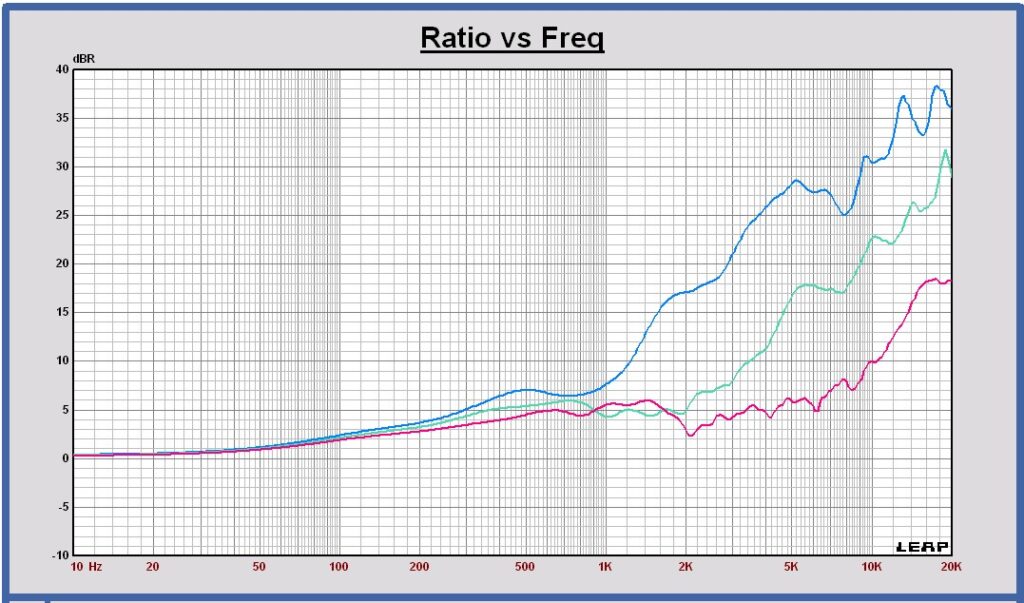
- The 3 transducers show a smooth DI curve as a function of frequency. In the medium frequency region it is realized by the asymmetric horizontal position of the midrange and the tweeter on the front baffle.
- The DI dip of the tweeter at 2 kHz is caused by a diffraction by the top edge of the front baffle. The tweeter operating range will be chosen at a higher frequency.
Analog passive crossover filter
A Linkwitz-Riley 4th order crossover filter is designed. To realize flat curves for SPL, power and directivity index versus frequency, the crossover frequencies are chosen at 600 and 3200 Hz.
Crossover filter targets LR4 at 600 and 3200 Hz
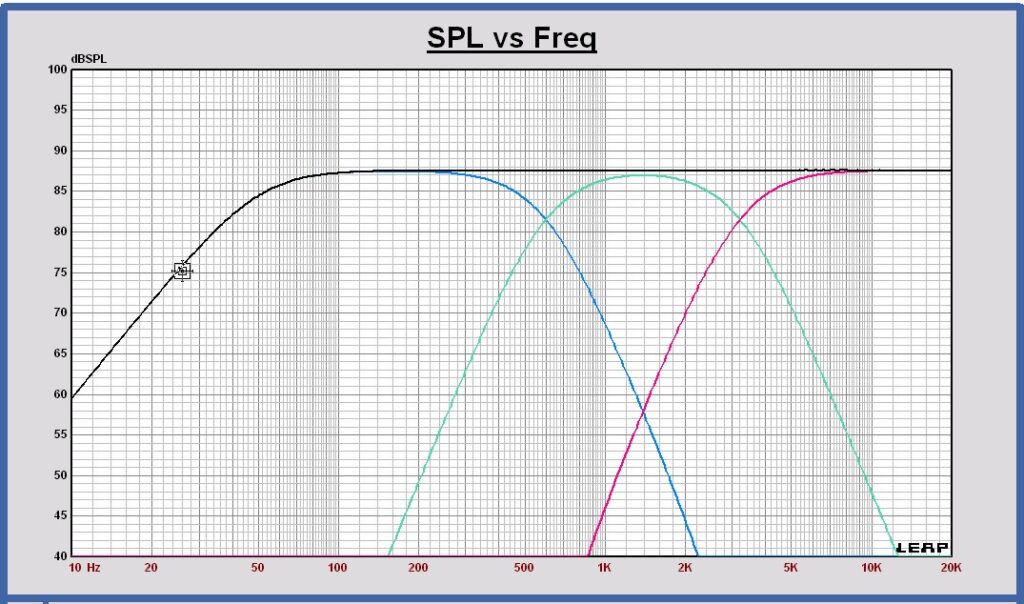
Crossover filter schematic
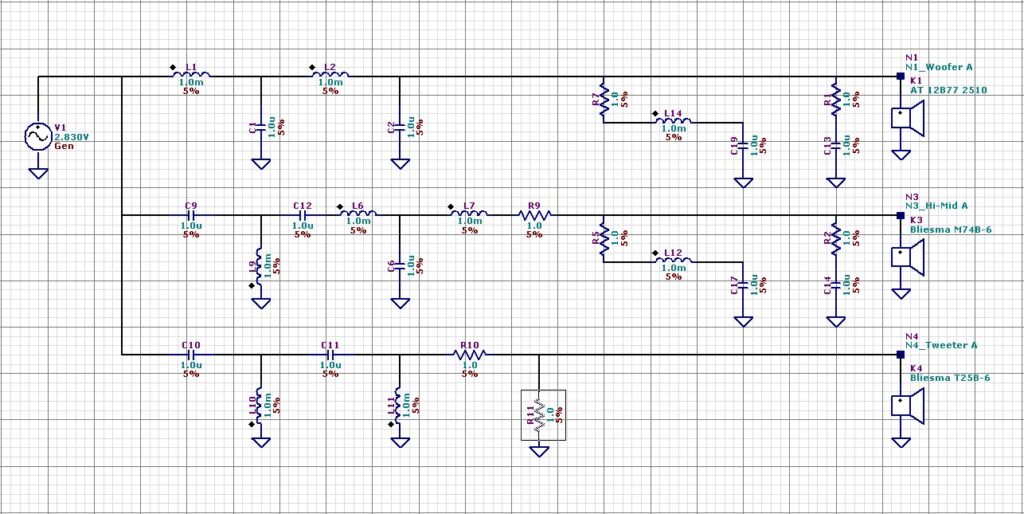
SPL on axis of the filtered drivers and the sum at 1m, 2.83 Vrms
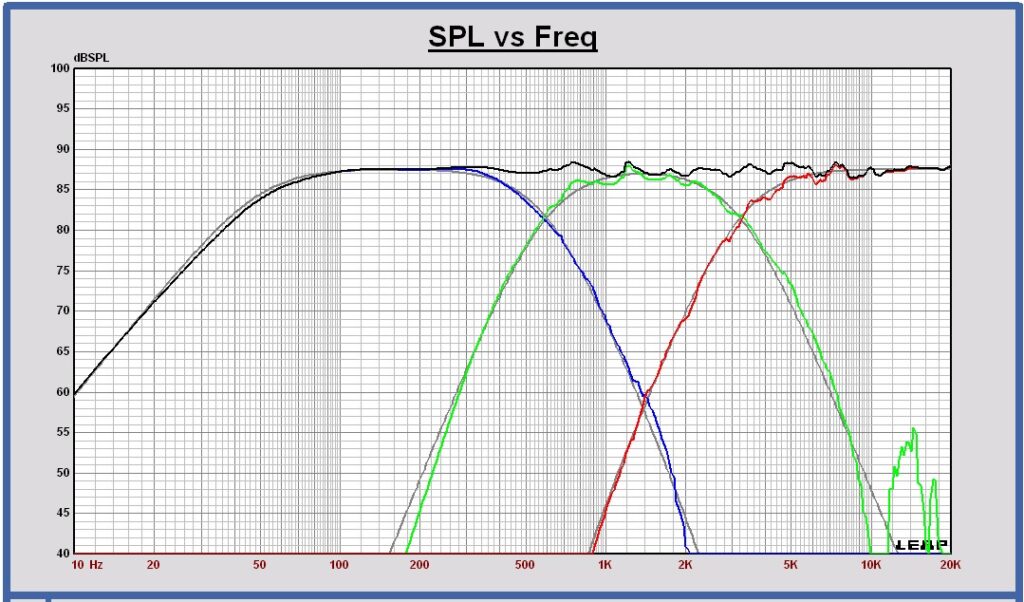
SPL horizontal off axis of the sum at 0 , 15, 30, 45 and 60 degrees at 3m, 2.83 Vrms
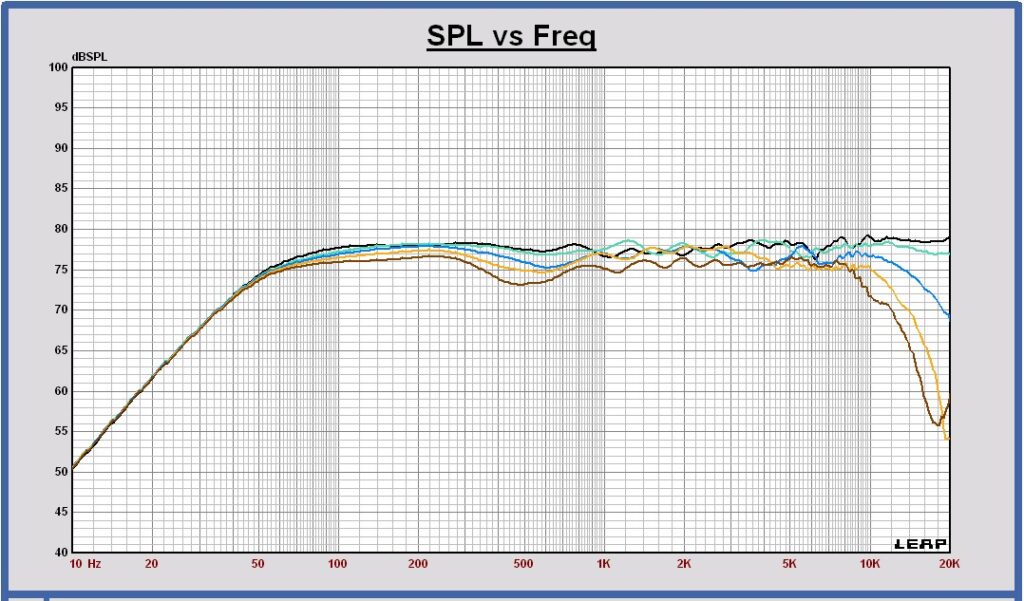
Power response of the filtered drivers and the sum in free space at 3m, 2.83 Vrms
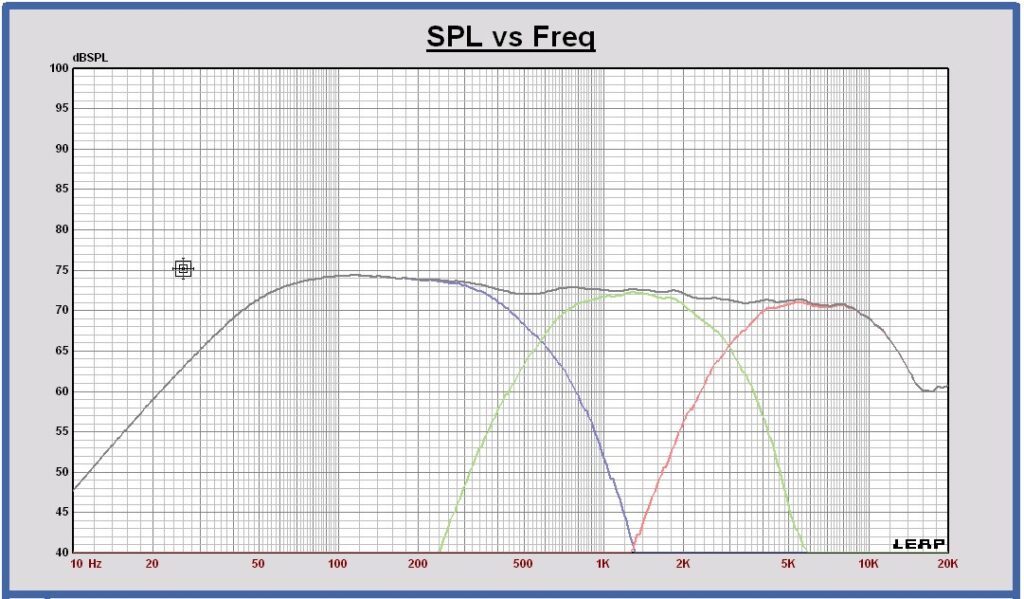
Directivity Index in free space of the filtered drivers and the sum
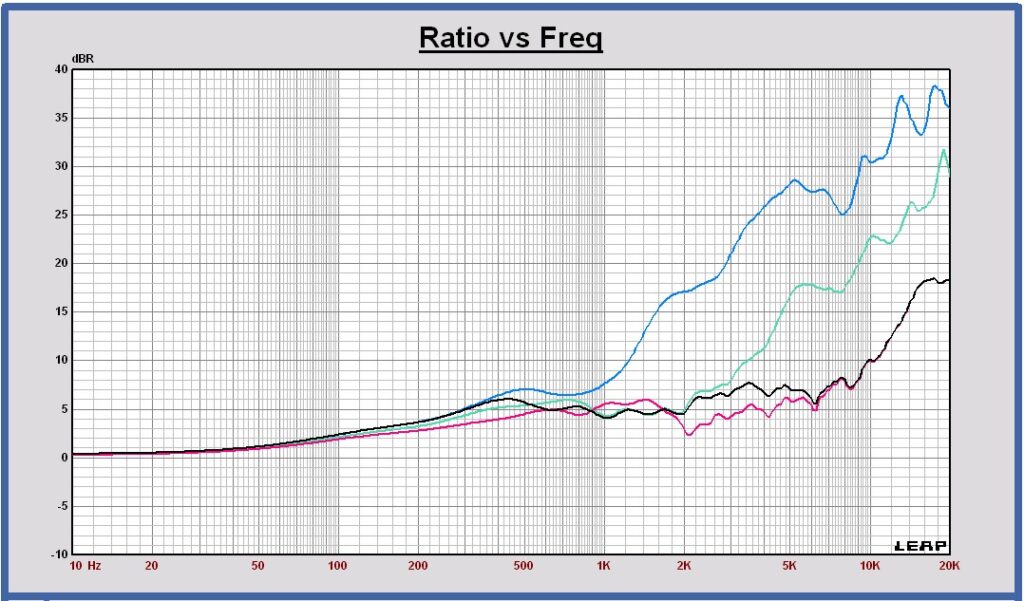
Maximum excursion and maximum SPL with the LR4 filter
With the designed Linkwitz – Riley 4th order filter, the woofer has a maximum excursion of 8.2 mm peak at 50 Hz for a voltage of 28 Vrms at the input of the filter.
The excursion of the midrange and the tweeter have been calculated also at 28 Vrms.
Excursion at 28 Vrms of woofer (blue), midrange (green) and tweeter (red)
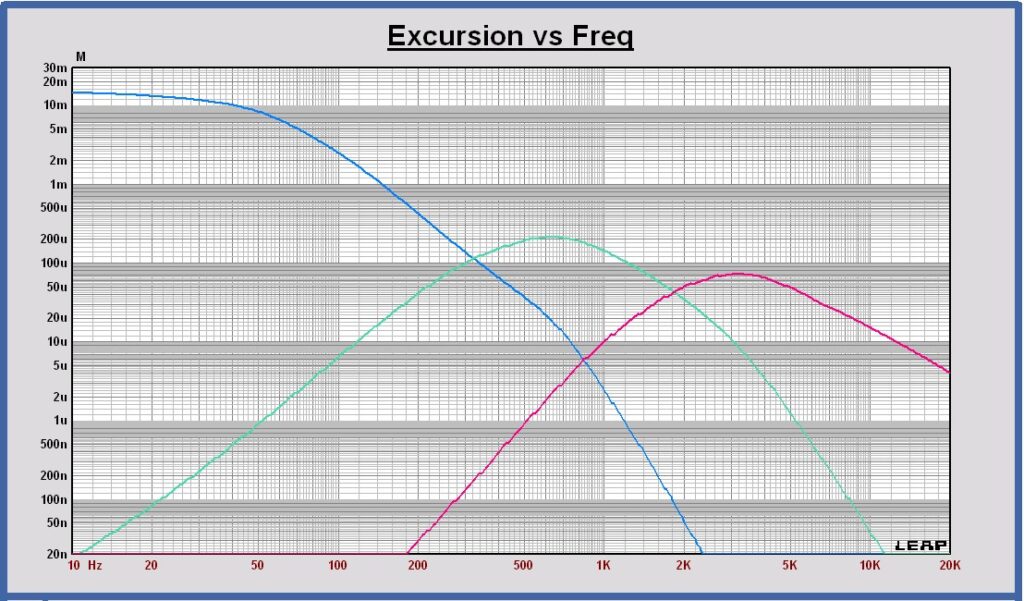
The midrange excursion is maximum at 648 Hz and equal to 0.214 mm peak.
The maximum specified linear excursion of the Bliesma M74B-6 is 1.2 mm peak.
The tweeter excursion is maximum at 3337 Hz and equal to 0.073 mm peak.
The maximum linear excursion of the Bliesma T25B-6 is 1.0 mm peak.
Maximum SPL
The maximum SPL for the operating frequency range 50 – 20000 Hz at maximum excursion of the woofer is 108 dB at 1m, 28 Vrms at the input of the crossover filter.
